What are Lord Hayagriva Facts, History, Information, Importance, Significance | What is the story behind Hayagriva? | Which day is best for Hayagriva? | What is the power of Hayagriva? | Which avatar killed demon Hayagriva? | Is Hayagriva God or demon
Namaste friends, how are you doing today? Welcome to #BhagavanBhakthi website / blog.
Bhagavan Lord Sri Vishnu (Venkateswara, Srinivasa, Balaji, Krishna, Rama, Trivikrama, Narasimha, Vamana, Vasudeva, Mukunda), Goddess Lakshmi (Rukmini, Satyabhama, Sita, Kamala, Maya) and Lord Sri Hanuman blessings to you and your family!
In this website / blog, you will always learn about #Hinduism #Sanskrit language.
Also subscribe to my YouTube channel #BhagavanBhakthi to view videos about #Hinduism #Sanskrit language.
Just before going to the “What are Lord Hayagriva Facts, History, Information, Importance, Significance | What is the story behind Hayagriva? | Which day is best for Hayagriva? | What is the power of Hayagriva? | Which avatar killed demon Hayagriva? | Is Hayagriva God or demon“, let us have a brief idea and information.
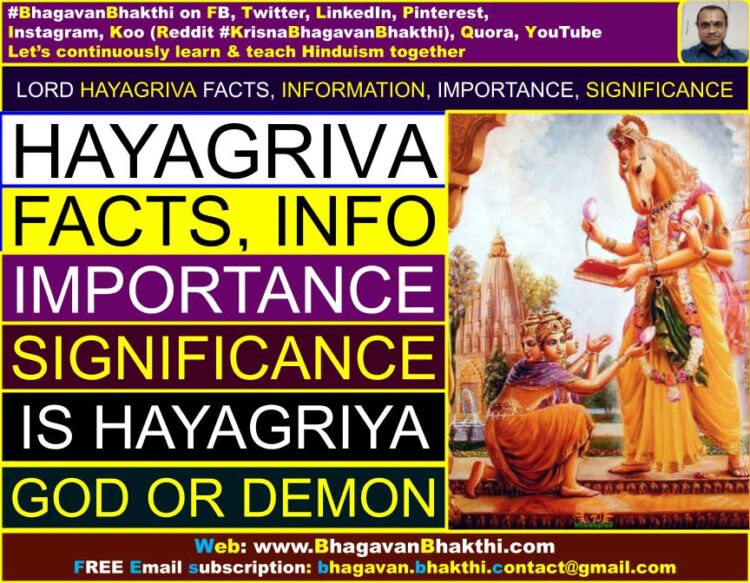
First let us know the meaning of the name Hayagriva: Hayagriva = Haya + Griva = Horse + Neck. This means, Bhagavan Sri Vishnu in the avatar of Hayagriva is in the form of Horse headed Supreme God of knowledge and wisdom.
On Shravana Shukla Purnima (Full Moon day in the Lunar month of Shravana Masam / month) is recognized as Lord Hayagriva Jayanti, that is:
This is the day Bhagavan Sri Vishnu took the avatar / incarnated as Bhagavan Sri Hayagriva and restored lost Vedas and the day generally coincides with Upakarma.
Bhagavan Sri Hayagriva also means the one who has the most divine and most beautiful throat (Hayagriva = Haya’s griva = Horse’s throat) from where all the divine knowledge (Vedas etc.) has been articulated and has been demonstrated.
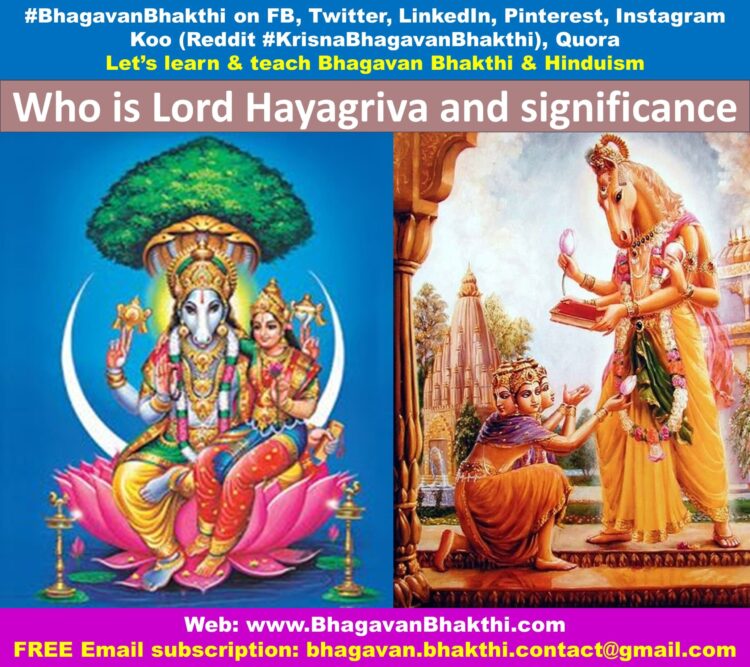
Bhagavan Lord Sri Vishnu in His avatar as Bhagavan Sri Hayagriva has killed the demons known as Madhu & Kaitabha to restore the lost Vedas, which was stolen from Sri Brahma Deva by these two demons. We can find a reference of this in Srimad Bhagavatam in 2nd and 7th Canto.
The demons Madhu and Kaitabha, are personification of passion and ignorance and Bhagavan Sri Vishnu as Bhagavan Sri Hayagriva is the Supreme Lord of Knowledge and destroyer of ignorance.
Now, let us check out few aspects related to Bhagavan Lord Sri Hayagriya who is in the form of a divine Horse.
Interestingly, Bhagavan Sri Hayagriva is not only mentioned in the Hindu grantas (Hindu divine books), but also in Buddhist works and He is a god not only in India but in several countries of South East Asia like Nepal, Tibet, China, Bhutan, Japan etc.
As said above, Bhagavan Sri Hayagriva is linked with the divine knowledge, learning and wisdom.
Bhagavan Sri Hayagriya with the divine horse head is very clearly is in the color white, and He is is seated on a Kamala / Divine lotus. Here, white represents clarity, purity, virtue, dharma, wisdom, truth etc. of Bhagavan Sri Hayagriva.
In the divine Hindu Vedas, particularly Rig Veda, there are numerous shlokas, references which is dedicated to a Bhagavan Sri Hayagriya of horse form.
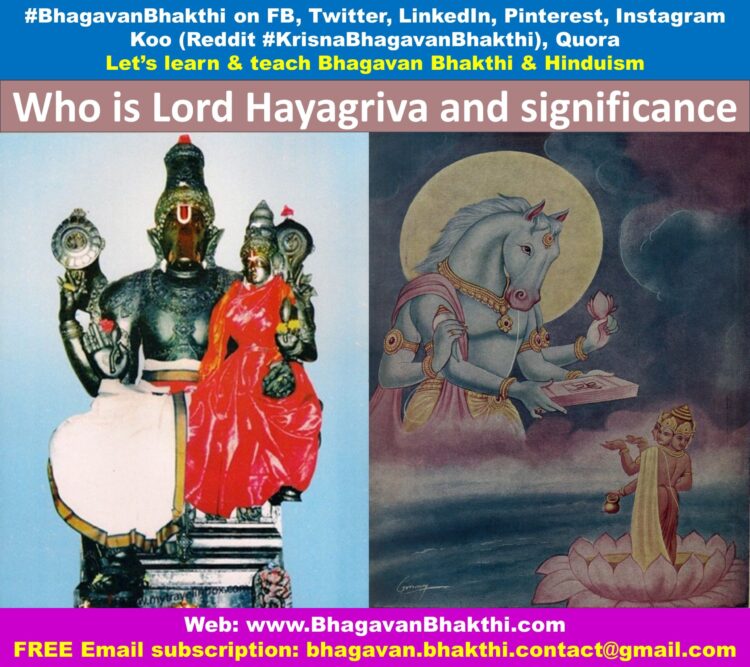
Many granthas (Divine Hindu books) give references of the legends of Bhagavan Sri Hayagriva which are very clearly found in the Mahabharata and the Puranas too.
Even in Devi Bhagavata, Bhagavan Sri Hayagriva killed the demon which had came in the form of a horse and also the demons name was Hayagriva.
In Skanda Purana, the story of Bhagavan Sri Vishnu-Hayagriva is related in chapter 14 & 15 of Dharmaranyakhanda.
The Vishvaksena allots a northern direction to the world occupied by Bhagavan Sri Hayagriva. This is called Bhagavan Sri Hayagriva Loka. The Naradiya Samhita also allocates a similar world to Bhagavan Sri Hayagriva.
The Nilamata Purana refers to Bhagavan Lord Sri Hayagriva in the present Kashmir region.
The grat ‘Pancharatna Agamas’ also mention about Bhagavan Sri Hayagriva. The Agamas are a body of religious-cum-philosophical literature which trace their origins to the Vedas.
The agamas have an exclusive work devoted to Devatas (Demigods) and it is called ‘Hayashira Samhita’. It is here that we find mention of Bhagavan Sri Hayagriva. Regarding this scholars say, is an avatar of Bhagavan Sri Vishnu.
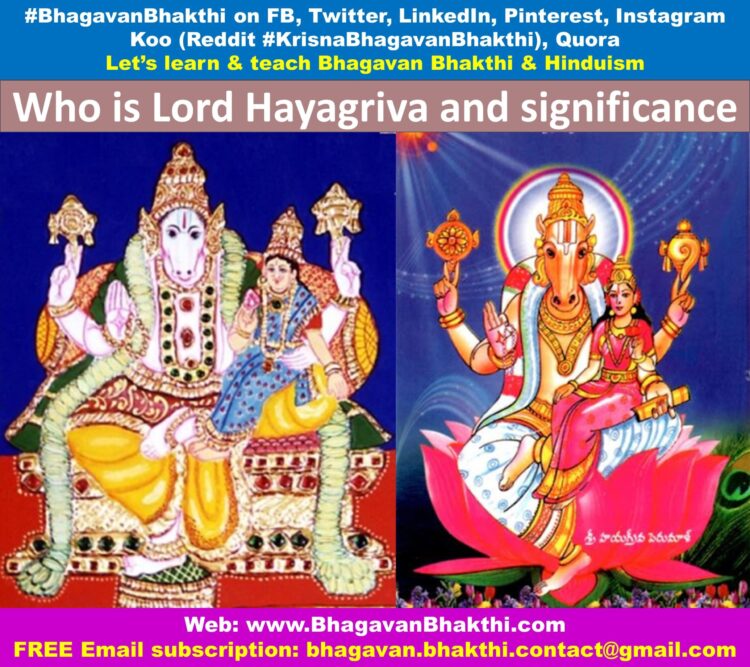
The Matysa Purana says that, Bhagavan Sri Vishnu’s avatar Bhagavan Sri Hayagriva preceded Matysa avatar. However, the Vaman Purana contradicts this and says Bhagavan Sri Hayagriva is the third incarnation of Bhagavan Sri Vishnu.
The Garuda Purana places Bhagavan Sri Hayagriva after Bhagavan Sri Dattatreya.
In the divine Sanatakumara Samhita (Sanata Kumara was one of the four spiritual and manasa putras / sons of Sri Brahma Deva), Bhagavan Lord Sri Hayagriva is placed alongside Sri Surya Deva and Sri Chandra Deva.
In the Vamana Purana, Prahlada worships Bhagavan Sri Vishnu’s form Bhagavan Sri Hayagriva at Ashvateertha near Kanauj.
This Vamana Purana also speaks of the worship of Bhagavan Sri Hayagriva in different regions of India, including Assam and in the Krishna (river) regions.
The Hayagriva Upanishat belongs to the Atharvana Veda. This tells us about the divine uses of chanting mantas relating to Bhagavan Sri Hayagriva.
The Tantras also mention about the Bhagavan Sri Hayagriva. For e.g., ‘The Meru Tantra’ gives us knowledge on several aspects relating to Bhagavan Sri Hayagriva. The Yogini Tantra deals with the power of Bhagavan Sri Hayagriva.
The avatar of Bhagavan Sri Hayagriva is believed to have come about on a Purnima (full moon day) in August (Shravana-Purnima ) and on the ninth day of Navaratri.
There is a verse in the Pancharatna Agama that deals with the Hayagriva. It says like this:
ज्ञानानन्द मयं देवं निर्मल स्फटिकाकृतिं |
आधारं सर्वविद्यानं हयग्रीवं उपास्महे ||
ಜ್ಞಾನಾನಂದ ಮಯಂ ದೇವಂ ನಿರ್ಮಲ ಸ್ಪಟಿಕಾಕೃತಿಂ |
ಆಧಾರಂ ಸರ್ವವಿದ್ಯಾನಂ ಹಯಗ್ರೀವಂ ಉಪಾಸ್ಮಹೇ ||
jñānānanda mayaṃ devaṃ nirmala sphaṭikākṛtiṃ |
ādhāraṃ sarvavidyānaṃ hayagrīvaṃ upāsmahe ||
This shloka is now the prefix to the Bhagavan Lord Sri Hayagriva Stotram of the renowned 13th-century Srivaishnava poet-philosopher Nigamanta Mahadeshika popularly known as Vedanta Deshika (1268-1370).
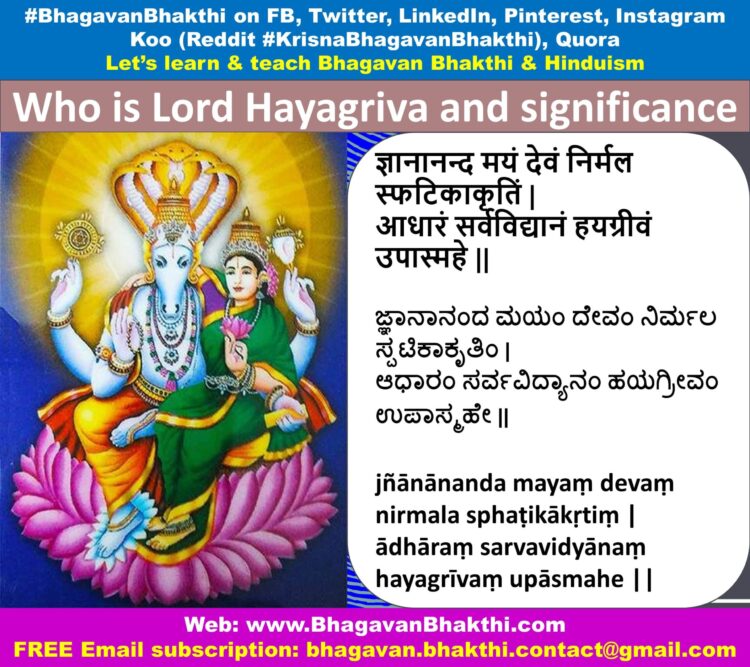
This Stotram is one of the earliest compositions of Vedanta Deshika. Consisting of 32 aksharas (alphabets), it is a beautiful hymn on the attributes of Bhagavan Sri Hayagriva.
It is said that it was Sri Garuda Deva (Bhagavan Sri Vishnu’s mount) himself who appeared before him and taught the Bhagavan Sri Hayagriva Mantra.
Vedanta Deshika says: विशेषवित्पारिषदेषु नाथ विदग्ध गोष्टीसमराङ्गणेषु |
जिगीषतो मे कवितार्किकेन्द्रान् जिह्वाग्र सिंहासनमभ्युपेयाः ||
ವಿಶೇಷವಿತ್ಪಾರಿಷದೇಷು ನಾಥ ವಿದಗ್ಧ ಗೋಷ್ಟೀಸಮರಾಂಗಣೇಷು |
ಜಿಗೀಷತೋ ಮೇ ಕವಿತಾರ್ಕಿಕೇನ್ದ್ರಾನ್ ಜಿಹ್ವಾಗ್ರ ಸಿಂಹಾಸನಮಭ್ಯುಪೇಯಾಃ ||
viśēṣavitpāriṣadēṣu nātha vidagdha gōṣṭīsamarāṅgaṇēṣu|
jigīṣatō mē kavitārkikēndrān jihvāgra sinhāsanamabhyupēyāḥ ||
For Vedanta Deshika, Bhagavan Sri Hayagriva has four kamala hasta (lotus hands), with one bestowing knowledge; another holding books of wisdom. The other two hands hold the Shankha (Conch) and Chakra (Discus).
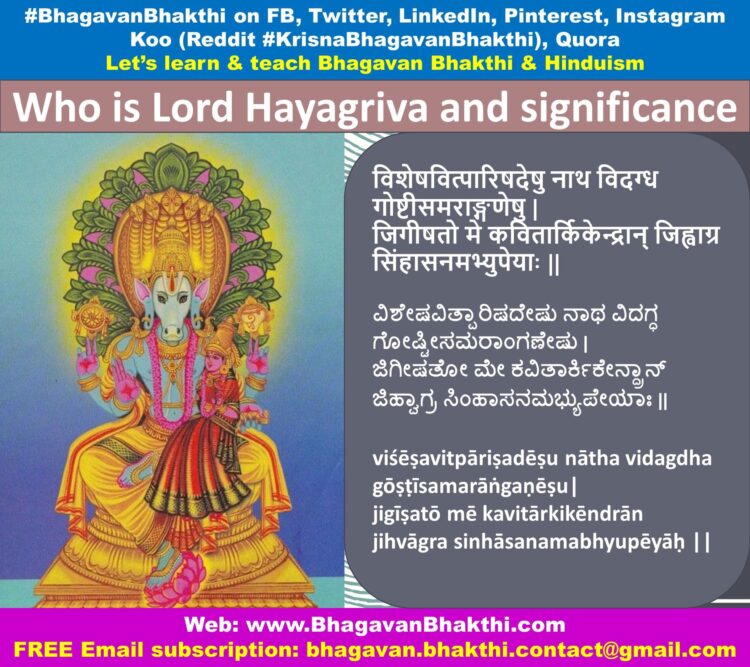
A great Vaishnava Saint Sri Vadiraja Guru Ji in his ‘Hayagriva Sampada stotram, says:
hayagriva hayagriva hayagriveti vaadinam |
naram munchanti paapaani daridramiva yoshitah || 1 ||
hayagriva hayagriva hayagriveti yo vadet |
tasya nihsarate vaanee jahnu kanyaapravaahavat || 2 ||
hayagriva hayagriva hayagriveti yo dhvanih |
vishobhate cha vaikunTa kavaatodghaatanakshamaH || 3 ||
shloka trayamidam punyam hayagreevapadaankitam |
vaadiraaja yatiproktam pathataam sampadaam padam || 4 ||
|| Itee Sri MadVaadiraja Pujya Charana Virachita Hayagriva Sampada Stotram Sampurnam ||
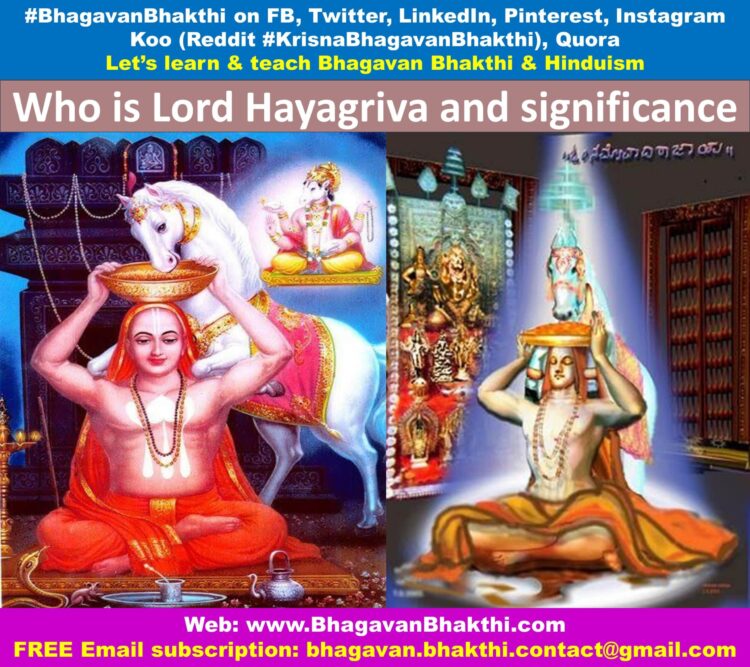
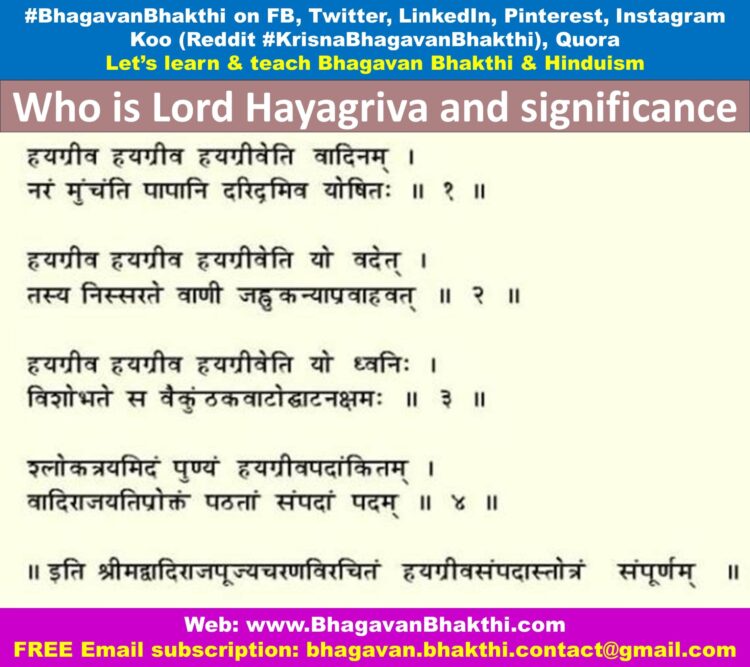
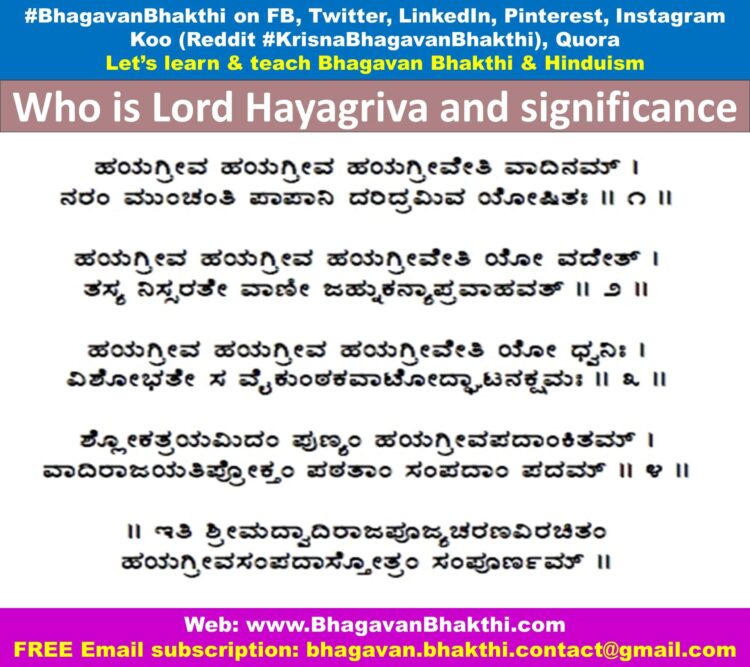
Apart from the avove two stotrams, we can find Bhagavan Sri Hayagriva stotram in the Garuda Purana. This is part of a chapter on Hayagriva Pooja Vidhi. The other stotram is in Skanda Purana and it is part of Brahma Khanda, Hayagriva Upakhyana.
In Buddhism also, Bhagavan Sri Hayagriva is depicted as a fierce and awesome God, whose wrath knows no bounds. In the Mahavairochana-sutram, Bhagavan Sri Hayagriva is described as one wearing a garland of skulls.
Here, he is in the form ‘Krodha Vighnantaka’ (Someone who ends the inauspiciousness). It is very interesting to note that, for the Buddhists, Bhagavan Sri Hayagriva is an avatar of Bodhisattava.
It is interesting to note that Bhagavan Sri Hayagriva transformed from a Brahmanical God of knowledge and purity to a fierce and intimidating God for the Buddhists.
This transformation is traced by Robert H Van Gulik in his work: “Hayagriva: The Mantrayana aspect of a Horse Cult in China and Japan”.
Another Buddhist work where Bhagavan Sri Hayagriva is mentioned is the Dharma Samgraha-a collection of ancient Buddhist texts.
Bhagavan Sri Hayagriva is depicted as a Horse God in several temples of India from north to south and from west to east. One of the best representations is in the Lakshmana temple in Khajuraho.
This was built by the Chandela Kings, the outer wall of this temple has images of over 600 Devatas (Demigods). This temple is entirely dedicated to Bhagavan Sri Vishnu.
The first ever historical representation of Bhagavan Sri Hayagriva can be found in several sculptures belonging to the pre-Gupta period. One of the earliest such carving can be seen in the Bharat Kala Bhavan museum in Varanasi.
Another pre-Gupta idol of Bhagavan Sri Hayagriva can be seen in a museum in Mathura. The image of Bhagavan Sri Hayagriva is depicted in the Vishwaroopa carvings of Deogarh, Samalji, Mandasor and Kanauj.
In South India, we can see images of Bhagavan Sri Hayagriva in the Hoysala temple at Nuggahalli near Mysuru, Karnataka. Bhagavan Sri Hayagriva which Deshika so eloquently wrote about can be seen in Tiruvendipuram in Cudddalore district of Tamil Nadu.
Since Bhagavan Sri Hayagriya is in the meditating form, the horse God here is also called ‘Yoga Hayagriva’. There are deities dedicated to Bhagavan Sri Hayagriva in the Ranganatha Temple in Srirangam and in the Vaikuntha Perumal temple in Kanchi.
By the way, the presiding deity of Parkala Matha of Mysuru is Bhagavan Sri Hayagriva.
In Tibet too, Bhagavan Sri Hayagriva was initially worshipped in the horse form. Thanks to Atisha (980-1054), the Indian scholar from Bengal who was instrumental in spreading Buddhism in Tibet and other countries such as Sumatra.
Few other temples dedicated to Bhagavan Lord Sri Hayagriva in India are as given below:
1. At Tank Bund Road in Gandhinagar, Bangalore, 2. Sri Lakshmi Hayagriva Temple at Nanganallur in Chennai, 3. Chettypunyam Hayagriva Temple in Chengalpattu, Tamil Nadu,
4. Hayagriva Temple, North Mada Street, Tirumala and 5. Sri Lakshmi Hayagriva Temple at Machilipatnam in Andhra Pradesh.
6. Yes, definitely, who can forget the famous Bhagavan Sri Hayagriva Madhawa Temple in Manikuta, Hajo near Guwahati, Assam. This temple is revered by both Hindus and Buddhists.
There are temples dedicated to Bhagavan Sri Hayagriva in Yadagirigutta and Mahaboob Nagar in Andhra Pradesh, Madurai in Tamil Nadu and there is one in Pondicherry.
More information will be added to this on regular basis. Please this post and other posts of this website / blog to get the updated information.
To watch videos on #Hinduism #Sanskrit language, SUBSCRIBE to my YouTube channel from this link: #BhagavanBhakthi YouTube channel
To know more information about Bhagavan Lord Sri Vishnu, you can visit this link: Bhagavan Sri Vishnu on Bhagavan Bhakthi website
To know “Venkatachalam hill (Tirupati / Tirumalai) names in different yugas”, click this link: Venkatachalam hill (Tirupati / Tirumalai) names in different yugas
To know more about Bhagavan Sri Srinivasa / Venkatesha / Balaji, click this link: About Bhagavan Sri Srinivasa / Venkatesha / Balaji on Bhagavan Bhakthi website
Dear friends, if you need any clarifications about this post, kindly let me know, I will definitely try to answer all of them.
Also your one LIKE, one COMMENT, One Share, one SUBSCRIPTION is highly important.
This will help to know the quality of this content and also it will be helpful to know if any improvements is required for the content.
If you feel this content is useful to you and has helped you to improve your knowledge, kindly share this with your well-wishers.
Because “SHARING MEANS CARING”.
To receive FREE EMAIL SUBSCRIPTION about #BhagavanBhakthi, you can send an email to [email protected] from your email ID.
NAMASTE!
Sri Gurubhyo Namaha
Sri Krishnaaya Namaha
Sri Krishnaarpanamastu
Share in Social Media
Excellent write up and very informative & interesting too!!!
May God always bless you for this noble work.
🙏🙏🙏
Dhanyavad for your blessings and divine words.
Do read my other posts too to get more information on Hindu Sanatana Dharma. Keep in touch.
With blessings,
Shubhamastu!
Hayagriva temple attop a hill in thiruvahindrapuram, caddalore. Where Garuda gave Saint Vedantha Desikan the knowlegde about Lord Hayagriva and his mantras.